I see my auto-posting didn’t work out so well, but you got to look at Chase Brock’s smiling face all week. There are worse things. More interviews in the coming weeks.
I’ve spent the morning while I should be catching up on e mails, or at the very least unpacking, reading the YouTube Symphony fall-out. What the what?? Greg Sandow calls it an “orgy of self-congratulation” here; Anastasia Tsioulcas suggests that the project should have been about the journey and not the destination here; and Anne Midgette quotes YouTube marketing manager Ed Sanders as saying, “I don’t see any reason why this can’t spin out. It doesn’t have to
be us that does it. The platform’s there. If people want to go and
discover talent, this is a great way to do it, and I think this project
has shown it” here. As Anne points out, it does, in fact, have to be them, or someone else with $64K+ to spare.
So I read through those and a few e mails blog readers had sent (“The crowd loved it because someone told them to love it. The emperor is naked.”) (“Waste of money – my money and YouTube’s money – and a total embarrassment for Carnegie Hall.”) (“It was a three-ring PR circus.”) and then I finally came to the New York Times dot com and, upon seeing the photo, said out loud to no one, Oh My God.
While I was away, six people – one friend, two clients, three blog readers – sent me the Susan Boyle Britain’s Got Talent video:
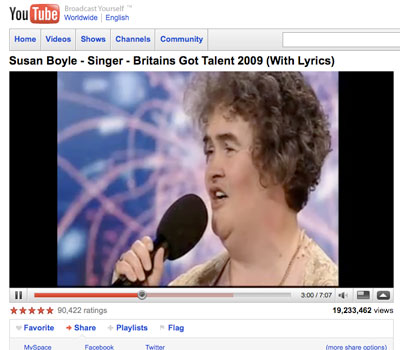 19 million views? 19 million views?? There’s a 19-million-person audience out there for a woman who looks and acts like that? Only on YouTube, as they say. Which is, of course, fantastic.
19 million views? 19 million views?? There’s a 19-million-person audience out there for a woman who looks and acts like that? Only on YouTube, as they say. Which is, of course, fantastic.
Let’s look at the other YouTube links my friends have sent me over the past few months. Where better to start than with Potter Puppet Pals in “The Mysterious Ticking Noise” –
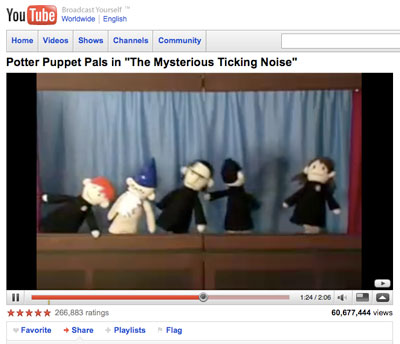 60 million views! 60 million views for five or less people/voices with homemade hand puppets.
60 million views! 60 million views for five or less people/voices with homemade hand puppets.
Next up, Extreme Sheep LED Art –
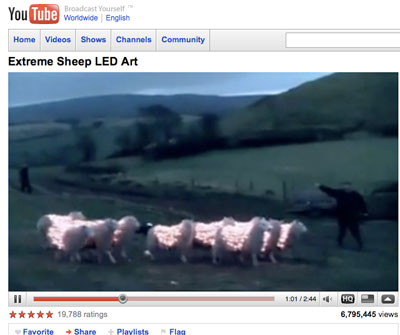 Nearly 7 million views, sheep with lights on them, weird herder-men with cameras.
Nearly 7 million views, sheep with lights on them, weird herder-men with cameras.
And last but certainly not least, the Single Ladies (BIG GIRL REMIX) –
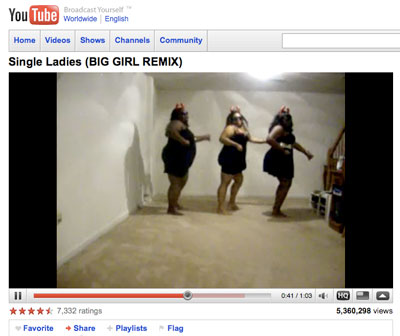 Watch to the very end – you won’t regret it. Recorded in what appears to be a basement, worthy of 5 million views, and we still don’t know why the women are wearing devil horn headbands.
Watch to the very end – you won’t regret it. Recorded in what appears to be a basement, worthy of 5 million views, and we still don’t know why the women are wearing devil horn headbands.
Susan Boyle wants a career as a singer; she says so in the clip. We also can’t quite count her as a YouTube sensation, because she was on a TV show. But what do the Potter Puppet Pals want? A Broadway show? Do the sheep-herders want LED art commissions? What on earth do the Big Girls want? Do they want anything, or did they just think it would be funny to record themselves dancing to ‘Single Ladies’, and then thought the result was entertaining enough to put on YouTube? Perhaps being a YouTube hit was their goal all along, and they filmed the video for that purpose. There’s no contact information on the video, so even if, say, The Joyce wanted the Big Girls, where/how would they find them? I guess the booker at The Joyce could post a comment?
Is it possible that people just want to be seen, without the chance of a proverbial or literal trip to Carnegie Hall? And beyond that, if you’ve made it on YouTube, have you made it – for whatever “real” is – already?
On his blog Think Denk, pianist Jeremy Denk describes the YouTube Symphony pianist’s audition video:
For some reason I found his video very moving. Something about the
Italian sunlight-or is it a spotlight?-streaming in from the
undisclosed above; something about the beaten-up upright, cornered
against the wall, guts exposed … But maybe most affecting is the dog in
the corner, slumped expectantly. I admire how the video begins without
people, with just piano and dog; who knows, perhaps only at this moment
of being filmed they realize they are both beasts?
[See Jeremy’s video report on the YouTube Symphony rehearsals, Ives and his enlarged(?) pores here, by the way.]
So how did the YouTube Symphony get from this,
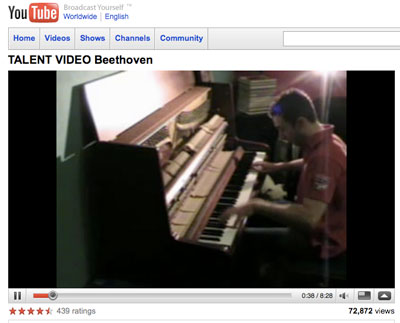 …to this,
…to this,
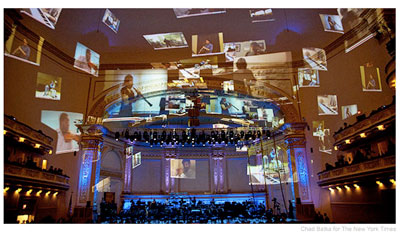 …and why?
…and why?
YouTube lets people be exactly who they are. If I filmed myself writing this blog entry, people would watch it. They would be bored out of their skulls, but someone out there would watch it. I’m wearing a five-year-old long-sleeved Dartmouth t-shirt, no makeup, and a bona fide scrunchie – no one wants to see that. Or do they? Probably. We want to see everything.
YouTube is gloss-less. And completely bizarre. And totally uncontrollable. It’s a PR nightmare, actually, so why did the YouTube Symphony concert get more press than any classical music concert I’ve ever heard of? Why was the end result a concert at Carnegie Hall, one of the most glamorous places imaginable? And not just any concert at Carnegie Hall; one with lights and projections and classical music celebrities. Why did it have to cost so much to produce? Why did it cost anything to attend? YouTube is free and accessible to everyone; just look at all the artists who e-auditioned. If the goal of the project was to democratize classical music, the end result would seem to prove that point was missed.
And if this is true to neither YouTube nor to Carnegie Hall (Will first-timers think all Carnegie concerts have projections and lights? Spoiler Alert!! They don’t!), who is gaining new audiences here? My father, who never looks at YouTube and only goes to Carnegie Hall when my clients are performing, handed me the Wall Street Journal preview and asked if I had heard of the project. Knowing about the YouTube Symphony will not make him comb through YouTube or start buying tickets to Carnegie Hall without my urging. The independent publicity company that handled the project and the Carnegie Hall press department have almost certainly expanded their media contacts through this endeavor, but what can they bring to that media going forward? Contacts are great, but there won’t be international camera crews waiting outside the next time the BSO plays at Carnegie.
Speaking of my dad, he got an e mail last night from one of his clients (he makes plastic bags, I haven’t finished his website yet). The client is a pizza chain, and the e mail was encouraging their contacts to “visit us on Facebook”. “Do they have to pay for that?” my dad asked. “I know it’s free for people to be on Facebook, but when companies just join to advertise, are there costs involved?” There aren’t, I explained, unless you buy ads, but generally no – anyone can have a free Facebook page, even if it’s created solely for advertising. Is Facebook Facebook when pizza chains can have pages? When your parents are on it? When there are ads for sale? Is YouTube YouTube when people post videos for the sole purpose of “being discovered”? Were 72,893 views for a strangely beautiful video of an unknown pianist playing the Waldstein sonata enough, or would none of it have mattered if he didn’t eventually get to Carnegie Hall?
Perhaps I’m being naive: YouTube has been one big audition all along, and this project just admitted it.

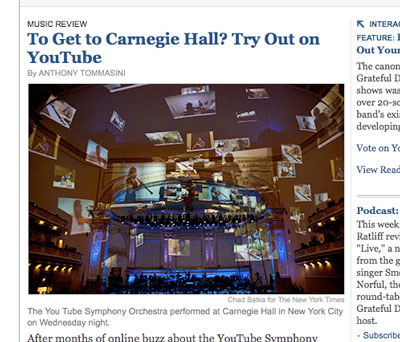
Great post. I love that you – creative as ever – chose to focus on YouTube’s audience/PR opportunities/brand here rather than Carnegie Hall’s. The benefit for Carnegie Hall is obvious: get people into the hall who have never been before (and will probably never come again, but no matter), and get mainstream press. What did YouTube gain from this? Will more people use YouTube because there was a positive New York Times review of their symphony concert? You can’t sell YouTube – people are either comfortable with it or they’re not, either use it naturally or don’t. And does YouTube really need press? Isn’t it above press, in a way? More specifically, isn’t it kind of press itself?
Audition indeed: the “Big Girls” aka SecretTrois appeared live on the Tyra Banks television show along with several other “Single Ladies” YouTube remake celebrities. YouTube in a lot of ways is deeply old-fashioned: a slice of vaudeville, a nod to the cabinet of curiosities and the fairground sideshow, the church/school/civic talent show…it’s leisure time, spent in the company of others…just *potentially* many more others that might be possible in actual space.